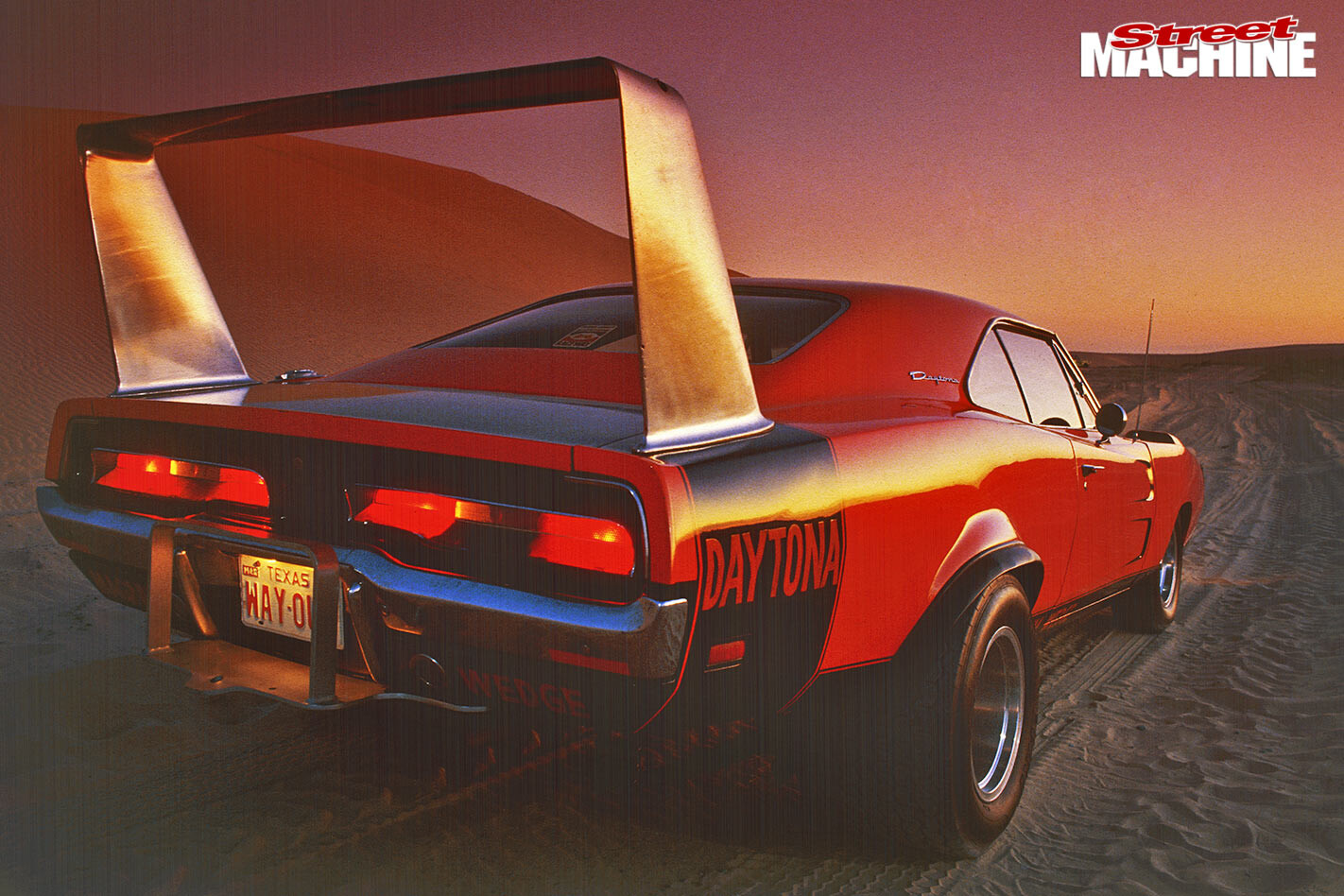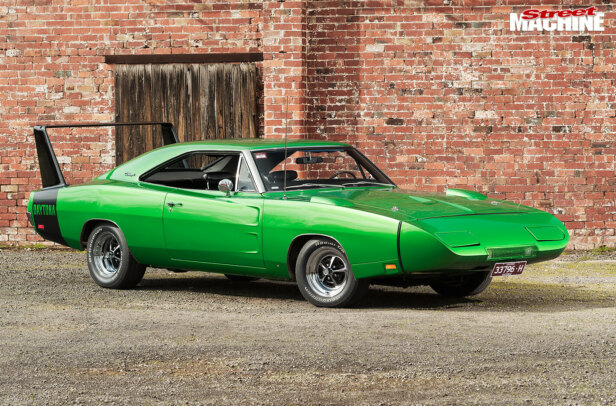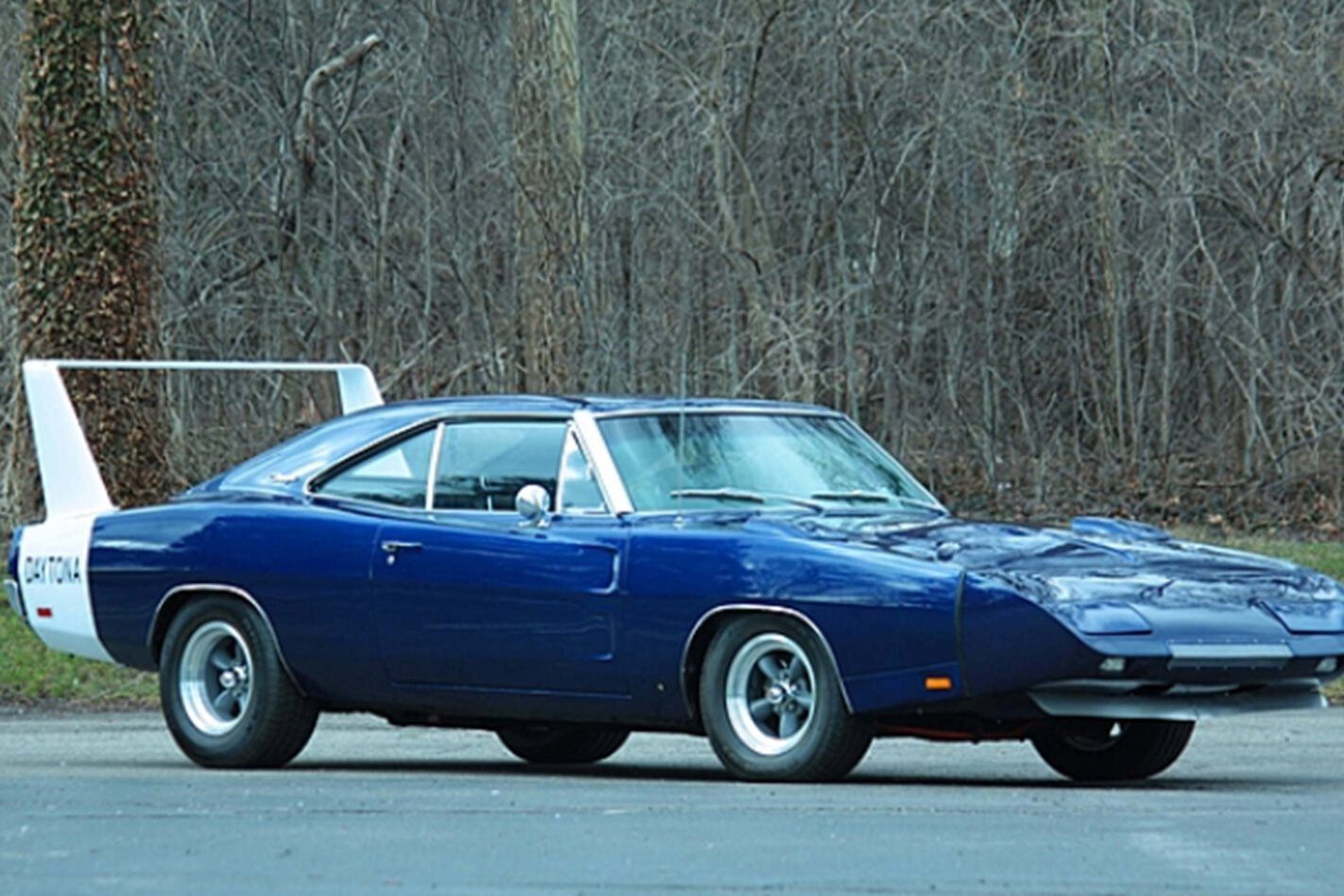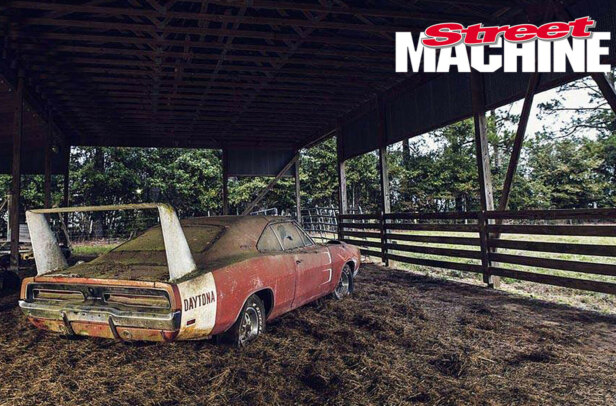Looking back on a low-flyin’ Daytona with wings of steel
This article on Kevin Monk’s Dodge Charger Daytona was originally published in the June 1986 issue of Street Machine
NOW you’d reckon this is just a Superbird clone, but nothing could be further from the truth. The Daytona model – and this car in particular – is very special. The Daytona was a NASCAR stocker and was years ahead of its time. So good, the authorities had to change the rules to stop it. But they couldn’t stop Kevin Monk getting his hands on this ultra-rare lightweight model.
The last competitive run by a Daytona was on the Bonneville salt in 1971. It was a fond farewell for one of the horniest cars ever built.
The Daytona story started in 1968 with the Dodge Charger 500. This was Dodge’s first attempt at slippery bodywork. And it worked. A blunt grille, fastback roofline and rear lip-style spoiler improved drag figures by around 30 percent. That meant a speed increase of 5–6mph at Daytona – on less fuel.
The scene was set for a balls-out encounter with arch-rival Ford. Aerodynamics worked and the Dodge boffins couldn’t keep that a secret for long. Ford responded with the Talladega. This was based on the Torino and in ’69 trim ran a sheetmetal nose that extended the car’s length by 14 inches. The big Henry was also successful, slipping through the atmosphere better than any other racer before it. A number of aerodynamic Mercury Cyclones also appeared, and by the end of the 1969 season the scorecard was 30 wins to 24 in Ford’s favour.
Dodge didn’t take kindly to this. It was working on a race package due for release in September of ’69, which included the most comprehensive aero-aids ever seen on a tin-top. A long metal nose, concealed lights, small grille area and underslung scoop-type front spoiler produced dramatic results. And the big news was out the back, where a huge wing was sitting high ’n’ proud.
But it wasn’t a tit-for-tat tack-on job, no, sirree. Daytona engineers rented Wichita University’s wind tunnel. They tested hundreds of different configurations on a 3/8th scale model and came away with the most effective NASCAR wind cheater ever produced. The rear wing, which was fully adjustable, sat 23 inches above the rear deck and was 58 inches wide. The horizontal wing surface could be moved backwards or forwards 7½ inches, so adjusting rear lift/downforce. Drag had been reduced by a further 23 percent over the Charger 500. This added another 8–10mph at Daytona and gave the drivers a quieter and more stable oval racer.
The car was a breakthrough but was also a problem to build. The number of add-on parts meant special production runs had to be made. But Dodge badly wanted to win – the top brass reckoned winning on Sunday meant sales on Monday. And they weren’t wrong. The Daytona caused a stir when it hit the streets. Some Yankee states wouldn’t register them. But most did and those with US$4000 willingly shelled out for a unique supercar.
Plymouth soon got in on the act, pumping out 1935 Road Runner-based Superbirds, which while appearing similar to the Daytona, actually shared very few common parts. Daytonas and Superbirds crushed the Ford opposition in 1970, winning 38 of the 48 Grand National races. They were times all Mopar freaks cherish. NASCAR stepped in and ended the low-flight fight at the end of that season. It reckoned the Daytona and other wind-busting racers weren’t a production shape. NASCAR preached the basic gospel about racing cars from the showroom – not building one-off specials.
The sound of jaws dropping could be heard across the southern states. Super stockers were dead! Standard bodies took over and Daytonas, Superbirds, Talladegas and Cyclones disappeared.
But Dodge didn’t want the Daytona to fade without a trace. It wanted to leave a monument to the machine’s achievements. The Bonneville salt flats were the last area left to conquer. The K&K Insurance teams and 1970 Grand National Champion Bobby Isaac were given the job of breaking as many records as possible. The team bolted on a couple of Holley four-barrels, 2.76 gears and special low-drag tyres. In total, the 600hp Daytona took 27 records. Most of these had been set by an aircraft engine-powered machine 20 years before. Two marks stood out – 217.37mph for the flying kilometre and 194mph average for 100 miles.
Even NASCAR was impressed. It presented Dodge with the Award of Excellence, mainly for advances in thermodynamics and fuel economy. At that time it wasn’t known how important these two factors would become in modern car production. Ironically, the Daytona’s effectiveness sounded the death knell for outrageous production machinery. These days, Daytonas are incredibly rare. Most were swiped from the showroom floor and raced. To find an original lightweight is incredible because only 44 were made from a run of 502. To find one outside the States was considered an impossible dream. Until we discovered Kevin Monk’s machine.
Kevin’s a car freak. At last count he owned 16 ’32 Ford rods, a whole host of other machinery and 45 garages! It was his love of ’32 Fords that brought man and machine together. In 1973 Kevin travelled to the US in search of ’32s. First stop was Los Angeles. There, he learnt of Mopar muscle and was quickly converted to the faith. A meeting with Big Willie Robinson (a legend who heads an organisation named the International Brotherhood of Street Racers) gave Kevin some clues to finding a Daytona for sale. Big Willie recommended the Daytona/Superbird Car Club of America – but they knew the score. If there were any spare Daytonas going around, they’d know about ’em – and have the inside running.
Kevin reckoned that was game, set and match. He faced facts and headed off in search of ’32s. With three other rodders in tow he travelled along Route 66. In Arkansas, they took a bypass off the main freeway and motored up a country road. Kevin spotted a long, orange car under a tree. They called into a farmhouse to investigate. It belonged to an elderly couple and – you guessed it – was a Dodge Charger Daytona!
Incredible as it might seem, the old fella’s missus used the beast as a shopping trolley until fuel prices started getting a bit tough. The Daytona was parked and a little Ford Pinto took its place. Kevin was beside himself. The Daytona had obviously been there a while – grass had grown up around it and there was farmyard grime everywhere. But it was all there. And the speedo read 23,000 original miles. The Aussie delegation primed the carb and test-drove for a couple of hours on the freeway and then he struck a deal – for US$2000! The owner reckoned it must have depreciated at least 50 percent, and that was a fair price.
But there was a catch. The farmer was heavily into old planes, having already restored one with another two on the way. He needed parts to complete his projects and any bits Kevin found would conclude the deal. Our man took the Daytona and continued along Route 66. He found the parts and closed the deal.
But the adventure didn’t stop there. In 1973 there existed a 98 percent import duty on cars. There was no way the authorities would cop the Daytona’s US$2000 price tag. There had to be a way around the problem. Kevin bought a tin of heavy-duty grease, sealed any gaps in the body and poured a couple of litres of engine oil over the entire car. Then drove around an LA construction site for an hour or so. The dust and muck that stuck artificially devalued this classic in a hell of a hurry.
The original wheels and rear wing were taken off and put in the boot. Then Kevin broke the centre of the boot lock with a screwdriver – it was a long way back to Oz and Kevin wanted to keep everything he’d paid for. When it hit the docks, the customs officials didn’t bat an eyelid for the Yank junker. Kevin soon had the car back at the garage, totally stripped and rebuilt. And that’s where its true identity was discovered. Lightweights came with a metal rear wing, and when Kevin stripped the paint he discovered a few tell-tale signs. This car did have a metal wing, it had no undercoat (to reduce weight!) and carpet with no underfelt. Kevin resprayed the Daytona in a Holden colour, Sebring, which was as close to the original as he could get. The RHD conversion was completed and our rego mob had no alternative but to hand over the plates. The Daytona’s details were filed on the federal rego computer, where nosey cops can read all about the car’s legality. But they don’t get many opportunities. You can’t take risks with a super stocker.
KEVIN MONK
DODGE CHARGER DAYTONA SPECS
Featured: June 1986
Paint: Holden Sebring
Engine: 426 Hemi/440 Magnum
Gearbox: 4-speed manual/Torqueflite 727 3-speed auto
Cool info: The Daytona won its first race, the 1969 Talladega 500, with Bobby Isaac at the wheel. He went on to win the 1970 NASCAR championship in the car. Buddy Baker, meanwhile, became the first driver in NASCAR history to crack 200mph (322km/h), also at Talladega in a Daytona, in 1970.
Of the Daytonas made, just 70 were fitted with the 426 Hemi; the rest copped the 440 Magnum. Cars equipped with the Hemi are changing hands for up to US$300,000, while the 440-powered variants are selling for upwards of US$100,000




Comments